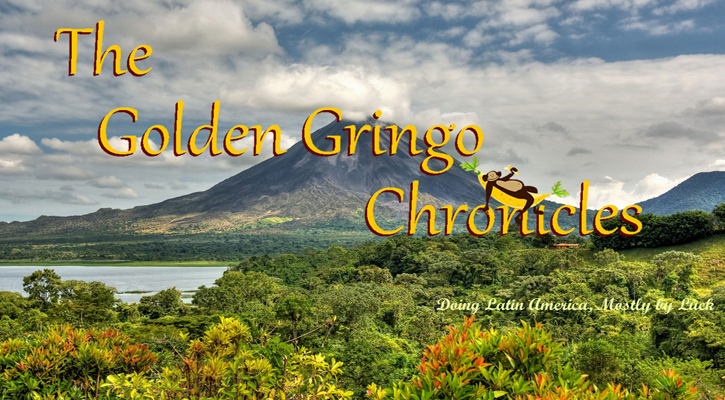

Edition 107 - July 2017
Published at Quepos, Province of Puntarenas, Costa Rica
Publisher: GGC Publications
Editor: Bob Normand, The Golden Gringo, aka "GG"
(©Copyright 2008-2017 All Rights Reserved)
"The mission and goal of the Golden Gringo Chronicles is to provide,
in an
informative and entertaining way, insight into
living
the
Costa Rican
experience as an expat."
1. Broken News: Shocking Statistics, Cell Phone Mania - Overly Connected, Manuel Antonio at the Movies, Sieg Heil!-Are You Kidding Me?
2. Rumble-Talk: Cordillera (Central Mountain Range) Active Again in at Least Three Places, Early and Heavy Rains Continue
3. Que Es Eso? (What is That?) Department: Is It a Swarm of Small Bees in Search of Honey, or Perhaps A Relic from Atlantis?
4. Feature: Costa Rica's New Airport (Third Generation in the Works); Also, History of Commercial Aviaton in Costa Rica
5. Feature: Inking It Up (GG Gets a Tatuaje). Tattoos can be fun.
6. Health Stuff: Thick Heads And Less Food Are Better for Old People, Say Universities; and José Must Be a Thick Head
7. What's-in-a-Word: Answer to Que Es Eso and Etymology of Tatuaje and Cordillera
8. ROMEO Corner: La Langosta Feliz - Matapalo
Wisdom of the Ages
|
 |
Publisher's Corner
RECENTLY RELEASED! Mariposa, A Love Story of Costa Rica RECENTLY RELEASED!
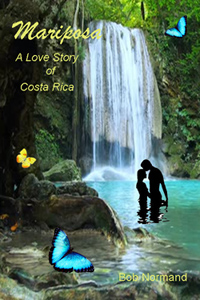 Five hundred years before the Spanish found the American
continent, around the end of the first millennium, Native Americans lived and prospered in Central America, including the land now known as Costa Rica. Truly a natural wonderland then and now, the natives were able to employ their farming skills and prosper from the rich soils, the forests filled with game, herbs, and spices, and the lakes and two oceans rich with fish and crustaceans.
Five hundred years before the Spanish found the American
continent, around the end of the first millennium, Native Americans lived and prospered in Central America, including the land now known as Costa Rica. Truly a natural wonderland then and now, the natives were able to employ their farming skills and prosper from the rich soils, the forests filled with game, herbs, and spices, and the lakes and two oceans rich with fish and crustaceans.
Mariposa, or butterfly, is a story about two young Native Americans, each a favored child of a chief, but of different tribes. These two tribes, historically hostile to each other, lived a few days march apart in the mountains north and east of Costa Rica’s central valley.
The two natives meet by accident, fall in love and begin to plan a life together only to be frustrated by events beyond their control. The lovers are eventually drawn to a mountain volcano which is thought by many to be the home of the gods, particularly Sib'ö, the Great Spirit, who they believe had created the world.
 The story as written incorporates the classic ending of Costa Rica's Legend of Zurqui, one that reflects the beauty, mystery and spirituality that is Costa Rica. Mariposa is available in both English and Spanish versions.
The story as written incorporates the classic ending of Costa Rica's Legend of Zurqui, one that reflects the beauty, mystery and spirituality that is Costa Rica. Mariposa is available in both English and Spanish versions.
Preview the Book (English) on Amazon.com at: Mariposa Preview (This is Chapter 1 in its entirety):
Shocking Statistics
When GG lived in Florida he learned that the central west coast of that beautiful state along the Gulf of Mexico was the lightening capital of the United States.
 |
| Lightening Discharge Near San José |
Sometimes I would drive the car from where I lived to the public parking lot at the beach on Siesta Key (5 mins) and watch the afternoon storms come onto shore. The lightening show was often colorful and dramatic.
So I recently read with interest that the west coast, the Pacific side of Costa Rica, offers a similar experience and may be one of the top lightening areas in the world. I can verify that some of the storms that I've seen moving from the Pacific onto the coast and into the Central Valley were second to none in drama, colorfulness and intensity.
ICE (Instituto Costarricense de Electricidad and pronounced ee-say), the national power company (in the beginning I confused ICE with the U. S. immigration organization), has placed seven detectors around the country in an effort to better understand discharge patterns and better protect our electrical and telecommunications infrastructure. These detectors picked up 1,650 discharges in the first two days of June alone and if the rate of discharges so far this year continues, there will be a total of almost 300,000 for the year.
Dude, that's a lot of flash in the air and static in the hair.
Cell Phone Mania - Overly Connected
It wasn't long ago that having a cell phone in Costa Rica was a status symbol. Now, not only does just about everybody have one, they average almost two per person!
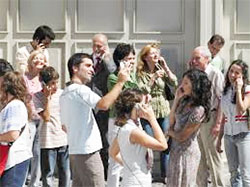 In 2006 there was one cell phone for every three people, a "penetration rate" of 33%. The Ministerio de Ciencia, Tecnología y Telecomunicaciones (Science, Tech and Telecom Ministry) recently issued a report stating cell phone penetration at the end of 2016 had reached 170%. That's measured by active cell lines and means there are more than 8.3 million cell phones in a country with 4.8 million people.
In 2006 there was one cell phone for every three people, a "penetration rate" of 33%. The Ministerio de Ciencia, Tecnología y Telecomunicaciones (Science, Tech and Telecom Ministry) recently issued a report stating cell phone penetration at the end of 2016 had reached 170%. That's measured by active cell lines and means there are more than 8.3 million cell phones in a country with 4.8 million people.
"Halo", Pura Vida!
By the way, cell phone penetration in the U.S. reached 81% in 2016, about half that of the Costa Rica rate. Do you think that all those cell phones vying for a somewhat shaky internet connection might have something to do with the fact that, in a recent study encompassing 87 nations, Costa Rica ranked #87; yup, that's right, at the bottom.
Hmmm, so what are all those Ticos doing with all those extra cell phones and why would you have more than one (personal vs business)? This is open question on which readers may speculate and proffer an opinion to GG at gg@)goldengringo.com.
Manuel Antonio at the Movies
A recent article in a electronic daily newsletter caught GG's attention; it was pointed out that Costa Rica is becoming a frequent on-site location for Hollywood movies. ¿Cierto? (Really?) Something to do with the natural wonder of the place, I suspect.
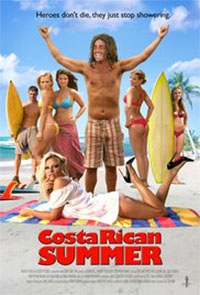 Two of the more recent movies use Manuel Antonio beach as the setting: "Costa Rican Summer" and "Surf School". After looking at the trailers, my inexpert opinion is that these gems won't offer a great deal of competition for the next set of Oscars for story, writing, acting or direction, but maybe they can get an honorable mention for cinematography because of the location. Both films make use of the beach panorama of the Rock Islands of Manuel Antonio as a backdrop.
Two of the more recent movies use Manuel Antonio beach as the setting: "Costa Rican Summer" and "Surf School". After looking at the trailers, my inexpert opinion is that these gems won't offer a great deal of competition for the next set of Oscars for story, writing, acting or direction, but maybe they can get an honorable mention for cinematography because of the location. Both films make use of the beach panorama of the Rock Islands of Manuel Antonio as a backdrop.
Both male leads in these films look so much alike that I first thought they were the same guy but I noticed that the two men go by different off-screen names. I just chalked it up to them both playing the same role, that of the oversexed, curly haired, fairly vacuous, often inebriated, half-naked (sometimes even less dressed if we're not lucky) surfing coach. Yes, I expect chastisement on this description from my beach buddies here.
To see the trailers for yourself go here:
Costa Rican Summer: https://www.youtube.com/watch?v=Owt4maED5s4
Surf School: https://www.youtube.com/watch?v=sRJOU0Fi9Ts
As an aside, I noticed that the two trailers have garnered over 2,700,000 views on YouTube with Surf School far out in front with about 85% of those views.
.
Surf's up, dudes.
Seig Hiel-Are You Kidding Me?
A gentleman living in Argentina, originally identified by his passport in 1945 as Herman Guntherberg, has been claiming that, in actuality, he's Adolph Hitler. Of course to claim that dishonor, he had also to claim that he's 128 years old (now that's the diet I want to talk about). Argentina was one of the places that Germans, both Nazi and non-Nazi, migrated to after the war (Italians too, giving rise to that wonderful cuisine in Argentina that is still there today).
 |
| Herman and His Friend |
The classic Hitler story is that he and his mistress Eva Braun committed suicide in his bunker as the Russians bore down on the Chancellery and that the bodies were burned in a pit outside the bunker using gasoline. That method, long before DNA was used, produced only unrecognizable bodies but inspection of the lower jaw bones by Hitler's dentist supposedly confirmed one of them was Adolph. The Russians spirited off the remains, which included a skull bone with a large bullet hole in it, to their homeland to avoid Hitler worshipers from setting up a memorial. In 1970 KGB head Yuri Andropov gave the order to destroy all the remains except the skull bone.
In 2009 that skull bone was further analyzed using modern DNA techniques and it was determined to be that of a woman (Eva Braun?). So the mystery of what happened to Hitler and his body is still a mystery and probably always will be.
Of course no one believes old Herman, not just because he's unlikely to be 128 (I'm with ya Herm, I feel like that some days) but because his ears aren't much of a match (see photo) come on Herm, maybe ~85.
Ach du lieber!
¡Pura Vida!
Eruptions Continue
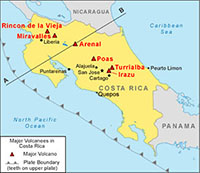 |
| Major Active Volcanoes in CR |
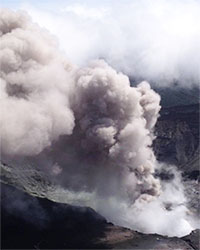 |
| Poas Eruption June 6 |
The central mountain range (Cordillera Central) continues to have volcanic activity in more than one of its several funnels.
Activity this past month saw eruptions from Turrialba east of San José to Poas, slightly northwest of Alejuela and all the way up to Rincon de la Vieja, in the far northwest of the country (see the map right for a smattering of the Cordillera's more active volcanoes.
While no major damage is being reported on a regular basis, there are continuing reports of eye and lung irritations all across the top half of the country and particularly in the Central Valley where 40% of the nation's people live. There also have been some National Park closings in the proximity of some of the more active volcanoes.
The Chronicles will have a more extensive article on the Cordillera in next month's edition.
Rains Continue
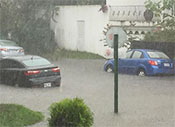 The early heavy rains reported in last month's Chronicle continued through much of June, particularly in the Central Valley where the photo right was taken.
The early heavy rains reported in last month's Chronicle continued through much of June, particularly in the Central Valley where the photo right was taken.
The country is still cleaning up after Hurricane Otto that landed in Nicaragua in November and proceed westerly over the top of Costa Rica. Some 20 odd bridges over various creeks and streams along the north corridor were swept away or need major repair. The work is due to begin shortly and the U.A.E. (United Arab Emirates) just made a grant of some $10 million to help in this effort.
السلام عليكم (Arabic for "Peace be upon you")
Check Out Recent Earthquakes Around the World Posted by the U.S. Geodetic Survey: Today's Quakes |
Search the Golden Gringo Chronicles Archives for Topics That Interest You
You can use our Archives to search for anything that has been written in more than 200 feature articles of the Golden Gringo Chronicles plus find Broken News items and ROMEO restaurant reviews. Enter your topic or item to search in the Google Search Routine below and follow the links offered from the search results. Suggestion: Enter only a simple, precise and unique as possible keyword or two in order to narrow the number of references retrieved:
Readers: Our publication is open to suggestions regarding future articles and will accept pieces written by others but we reserve the right to decline anything that the editorial staff (that's GG) thinks is inappropriate for this format. Send proposals, comments, suggestions, ideas, meaningless statements and jocular observations concerning the Chronicles to GG here: gg@goldengringo.com.
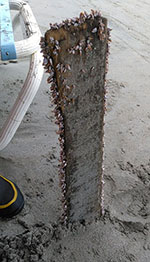
An amigo and I were lazing at the beach one day, enjoying the 78F Pacific Ocean water and commiserating about the price of rhubarb in China when my friend tripped over the object shown in the photo to the left.
The object was not plastic or metal but some kind of natural material. We quickly settled on it being a wooden board (it couldn't fool us); but what were all those little white and red doodads covering it?
Micro-butterflies perhaps? Small bees? What do you think?
Answer in What's-in-a-Word section below.
Late in May we noted the announcement by the Costa Rican government that a plan had been approved for a major new international airport to be located near Orotina, about 60 km/35 miles to the west of San José.
.
This has been a long time coming and GG can remember that the question of where to put the next airport has been talked about at least since I started coming to Costa Rica in 2003. At that time only four major U.S. airlines were flying here, with a non-daily smattering of connecting flights to and from other Central American airports such as Panama City. But even then it was obvious that the growth in international arrivals and departures in the coming years would outstrip the current airport facilities.
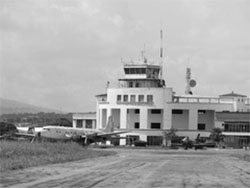 |
| San Jose's Original Airport Cerca 1945 |
The new airport will be the third generation of development of aviation facilities in Costa Rica. The first generation, the first commercial public airport, occurred with the opening of an international airport in 1940 (nicknamed "El Coco") which was located at La Sabana park on the west side of San José. The photo left shows the original terminal. I believe the aircraft shown parked at the terminal is a DC-6 - some of us remember these birds and have actually flown in them (as well as a DC-3, DC-8 and a DC-9). As they hadn't yet invented covered jet-ways back then, it must have been interesting running from the plane to the terminal in the rainy season. And the runway wasn't paved until the mid-1940's.
The government later turned the terminal into a heritage site and it now houses the National Museum of Contemporary Art.
 |
| Juan Santamaria Airport (SJO) - Alejuela Today |
With airline travel growing exponentially after WW II and to promote tourism, it wasn't long before the Costa Rican government realized a major new airport would be needed and, in 1951, construction of the current airport (Juan Santamaria - call letters SJO) was begun in Alejuela. It took until 1958 to complete its construction and the new facility was opened in May of that year.
During the late 20th century and into the 2000's SJO was expanded a couple of times with more gates being added and service facilities regularly updated. More recently, both international airports at Alejuela (previously mentioned Juan Santamaria - shown as "JS" on the map below) and the smaller one at Liberia were renovated and expanded. Yet in the last ten years it became apparent again that an even more substantial expansion of air facilities would be required to handle anticipated growth; and it has come to pass. The one runway at SJO is now very, very busy.
Passenger usage at Juan Santamaria alone reached 4.5 million in 2015, roughly one passenger for every person in Costa Rica, and that does not include the traffic at the other Costa Rican airports. Clearly, visitor growth has been dramatic. There are now nearly three dozen international and two domestic airlines, operating regularly scheduled flights into Costa Rica including seven U.S. carriers, and it seems like every couple of months these days a new airline announces that it's starting or expanding service (KLM just announced expanding its Amsterdam service to three times per week from one)..
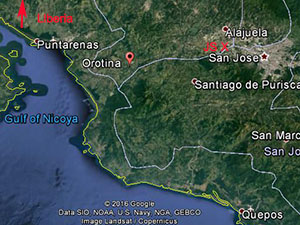 |
| Location of Orotina to San Jose and Quepos |
In the planning of the next aeropuerto, which already has taken several years, a few different sites were proffered for evaluation including sites in the Northwest (Liberia Region and northern coast), Quepos (south central coast) and Palma Sur, near the Osa peninsula and even farther south along the coast. In the end Orotina won out.
The report on the study recently issued by the government was almost 3,000 pages long and included 24 varied feasibility studies and was produced and managed by the Mott MacDonald Group, a well-respected global engineering and management company headquartered in the U. K. and who have 16,000 staff in 150 countries. The studies alone cost $1.8 million and included a site study, master plan, and some pre-design, financial and feasibility assessments.
The Orotina location makes sense for two important reasons: 1) it happens to be nearly dead center in the west side of the country, an area that is developing the fastest and 2) it's close to major highway intersections (see map above). Not far from Orotina, the coastal highway (Costanera Sur) runs south all the way to Panama, and the extension of that highway to the north joins Route 1, the InterAmericana, and goes all the way to the Nicaragua border. Also conveniently intersecting the north/south highway near Orotina is the new autopista that runs east/west from San José to the Pacific coast at Caldera just south of Puntarenas.
So the new airport will be in a convenient location to provide both access to the airport and quicker, easier movement of people to the Pacific coastal areas. Whether or not a typical San José based air traveler will find it convenient is another question (sounds like a 1+ hour commute from the capital versus the current half hour to Juan Santamaria), but I suspect both airports will get their share of use. I bet the authorities wish they could just pick up Juan Santamaria and relocate it to the south Pacific quadrant or to a spot about half way between San José and Limón, the next logical choices for main airports.
 |
| Artist's Rendition of New Airport at Orotina |
The new airport, as shown in the artist's rendition to the right, will occupy 1,200 hectares (about 3,000 acres) at the site near Orotina. Three phases of construction are envisioned, the first being the construction of two runways, various access roads and a 128,000 square-meter terminal (about 1.4 million square feet).
Phase one is expected to be completed and opened by 2026 and the new facility will then be able to handle approximately 7.8 million passengers annually. Completion of further expansion in phases two and three would bring passenger handling capacity to over 50 million per year (!). Where will they all stay?. Full 3-phase completion will probably not happen until the year 2050.
Airports like this are not cheap to build. Phase I alone is estimated to require $1.9 billion with a total cost to completely fill out the three phases in excess of $5 billion. Keep in mind that the total annual federal budget in Costa Rica is about $15 billion and almost half of that currently is debt. Beyond the direct cost of the airport alone, the study also concludes that several of the major highways including the relatively new autopista will need to be expanded to handle the increase in vehicle traffic.
Obviously beyond the means of the government to finance this project directly, consultants Mott MacDonald have stated that it is financially feasible as a public-private partnership (read that as more passenger taxes and fees will be needed to construct and run it).
Better start looking for partners amigos.
¡Solo Bueno!
I expect that some day in the distant future, 1,000 years from now perhaps, there will be bodies (maybe mine), exhumed and examined for unusual details in order to unlock the meaning of our age. Of course I speak tongue-in-cheek here because, in fact, future archaeologists probably won't have to dig as much as they will enjoy a never ending supply of electronic records currently being recorded about everything we now do, unlike what the diggers of old had to work with.
 One day recently, old GG was sitting with some friends having a cup of java when I noticed a tatuaje (tah-too-ah-hey, Spanish for tattoo) on the ankle of a friend. It was a simple tat, just a couple of small, less than 3" high palm trees in black ink. I found it intriguing and asked my friend: "Wear'djugetdat?". "A gent in Dominical (about 25 miles south of Quepos) did it for me.", says he.
One day recently, old GG was sitting with some friends having a cup of java when I noticed a tatuaje (tah-too-ah-hey, Spanish for tattoo) on the ankle of a friend. It was a simple tat, just a couple of small, less than 3" high palm trees in black ink. I found it intriguing and asked my friend: "Wear'djugetdat?". "A gent in Dominical (about 25 miles south of Quepos) did it for me.", says he.
Now GG, a Golden Warrior, (Golden Warriors are more successful than most these days, so I hear) has managed to log 73+ years on this globe without a tattoo, but I must quickly confess to a secret; I have long wanted one. My first inkling to get an inking occurred around 1975 (I was 32) and I was living in Brussels. I used to play Squash at a club with another American gent who worked at the same company as I did, and one day I noticed in the shower that he had a shamrock tattooed on his right butt cheek (his last name was Murphy).
 |
| Fleur-de-Lis Tat |
I started to think about putting a Fleur-de-Lis in the same place because my heritage is French. But today I'm glad I didn't do it for two reasons; 1) my butt doesn't present itself as often or as well as it used to and 2) who the hell is going to see it anyway?
But the palm trees renewed my allure for a tattoo so I called the gentleman in Dominical and made an appointment. Le Voila!, that's the resulting tattoo in the photo above left, but it's located on my right calf, not my derrière. Makes me feel tropical, it does.
 |
| Model of Ötzi the Iceman |
We may be living in the age of new interest in tattoos but the practice is ancient. The oldest tattooed corpse found to date was dug up in 1991 in the Alps between Austria and Italy. A gentleman warrior, he was given the name Ötzi the Iceman (aka Frozen Fritz) as he was found frozen in the middle of an Alpine glacier (I guess freezing really does preserve stuff). Carbon dating places Ötzi's life, which lasted between 40 and 50 years, somewhere in the fourth millennium BCE, around 3,400 BCE, making his corpse about 5,300 years old today.
Ötzi was about 5'2", 135 lbs. That's a body-mass index of 24, definitely not obese; Ötzi musta watched the carbs. Autopsy, carbon dating and DNA techniques are now so sophisticated that we are able to know a lot about Ötzi's life. He had numerous health problems including hardened arteries and gallstones, worn joints (I'm with you buddy), eggs of parasitic worms in his stomach, very high levels of arsenic in his system, probably from working in the mines (after all it was the Copper Age), advanced gum disease, tooth decay, an arrow wound in the shoulder, a stab wound in the hand, and a large blunt force trauma (like they say on CSI) dent in his head, a blow that probably caused his death. Busy dude.
Because of a peculiarity in his blood, Frozen Fritz has been linked to 19 currently living people in Austria (they're probably all trying to get his Social Security checks now).
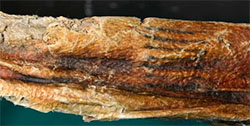 |
| One of Ötzi's Tattoos |
The other thing interesting about Ötzi is that he has been documented to have 61 tattoos (not shown in the model above). It is believed that the practice of tattooing goes back as much as 2,000 years before Ötzi and that it was combined with early forms of acupuncture for healing rituals.
Of course the ancient process of tattooing has changed with time but the idea has not. To create a permanent, harmless (let's hope), durable image on human skin you gotta embed the ink in the lower layer of skin (dermis) below the upper layer of skin (epidermis). In ancient times, designs were carved directly into the skin (ouch) and ash or pigment was introduced to the cut. The body's natural immune system then "encapsulates" the foreign objects, i.e., the ash or pigment. After the surface wound heals and the scab wears off, it becomes the permanent image.
The only difference in the modern process is that electric machines have taken over as the primary tool, although some of the old manual tapping techniques have been revived in places like Hawaii and Japan. In the modern version, the machine head contains one or a bundle of needles that rapidly oscillate. The rapid oscillation (plus my tattoo dude's good technique) is probably the reason why I was surprised to feel little pain during the procedure (kind of like the dentist and his high speed drill works, I guess).
Joseph the tattoo artist told me before starting that "It's going to feel like I'm scratching you." And that's exactly what it felt like, an irritation but certainly tolerable. Take a look at the video above which was taken when GG was getting the tat. (That's GGC's Chief of Electronic and Social Media Production, Nick, in the foreground and Director of Tattoo Artistry Joseph in the background).
Two days after I got the tattoo, when I thought I was in the middle of healing, a lady friend of mine who has a good deal of her visible surface covered with tats, inspected mine and then, without warning, gave me a solid whack on the tattoo with the palm of her hand, a slap that caused more pain then the tattoo process. "Just setting the ink." says she. When I grimaced, she gave me a smirk as if to say "You big wuss" (and that I am when it comes to pain).
So GG got his first tattoo, his first tatuaje. Will I do it again? Probably not, but I'm happy I did it this time. The cost of the modest double palm tree was under $100, fitting my budget. Others, with more detail, multi-colors and design complexities can run into the hundreds or even thousands of dollars. Check out the samples below:
 |
 |
 |
 |
| Full Body Tattoo | Samurai Shoulder | Mrs. M. Stevens Wagner, Most Famous Tattooed Lady | Doing the Full Indian Thing |
So who knows what I'll be thinking tomorrow. But for today wasn't it Mark Twain who said:
"Twenty years from now you will be more disappointed by the things that you didn't do than by the things you did. So throw off the bowlines. Sail away from the safe harbor. Catch the trade winds in your sails. Explore. Dream. Discover."
Yeah, baby, anchors away!
¡Pura Vida!
| Note: The information given in this section is offered as news information only and does not indicate GGC confirmation or denial of the accuracy of the treatment or a recommendation to pursue it, nor can we or do we guarantee the efficacy of the results nor validity of the conclusions proffered.
(how's that for a disclaimer?) |
Thick Heads And Less Food Are Better Say Universities
When my mom used to get frustrated at my behavior, and that was fairly often, she would sometimes describe me as "thick-headed" (I think it's a French-Canadian saying). So did several of my nun teachers for that matter (and they were Irish). Guess I was sometimes a real thick-head, but guess what mom, a thick head might be an advantage as I get older.
Researchers at Northwestern University in Chicago have been studying a special group of 80+ year olds that have retained cognitive abilities similar to what people in their 50's and 60's have. They have found for some reason that these people lose their brain volume at a significantly lower pace than average. Losing brain volume, or shrinking of the brain covering (cortex) can effect memory and problem-solving. Unfortunately no mechanism for the loss has yet been identified let alone a remedy, but it's a start in the right direction. (By the way, GG's test on lower carbs to improve memory is still in mid-experiment).
Meanwhile, over at Brigham Young University in Provo, Utah researchers think they have found a way to slow down the aging process. Just eating less might help. These scientists have tied a reduction in the production of "ribosomes" to caloric intake. Ribosomes in turn are responsible for making important proteins in cells. Slowing down the production of ribosomes through lower food intake allows the little rascal ribosomes to repair themselves and become more effective in making those proteins.
Studies so far have only been in mice but a 35% reduction in caloric intake of one group, versus another group of their buddies who were fed all they could eat, produced mice that were more energetic, suffered fewer diseases and lived longer as well.
Squeak.
José Must Be a Thick Head
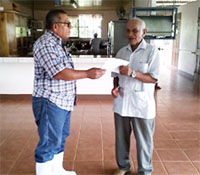 |
| José Flores Flores (right) Receiving His Degree |
There is a gentleman, a native of Guanacaste Province, that recently received a degree from the Instituto Nacional de Aprendizaje (National Institute of Learning - kinda like Extended Education) in Cultivo de Hortalizas (essentially Horticulture). His name is José Flores Flores (ironic that both of the horticulturist's family names are Flowers and Flowers). José never graduated from high school so the story is no big deal, right? Just another adult getting a late education, right?
Yeah, very late, you see there's one more very interesting fact about José; he's 110 years old. He's been working in the fields since he was seven, i.e., more than a century. Hard labor kept him healthy says he: “Work is healthy; if I stopped working, I would undo myself.” His teachers view him as being of high spirit and good nature. Don José is not through with his continuing education however, he's now looking forward to a course in hydroponics.
I hope someone is getting a cortex measurement on this dude, he's special (note also that he's thin).
|
Answer to Que Es Eso?
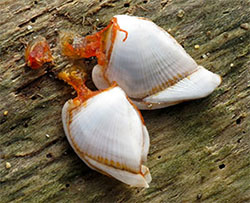 |
| Gooseneck Barnacle |
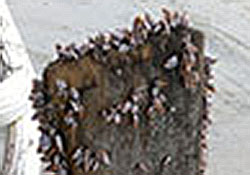 Fortunately my amigo who found this piece of driftwood had some educational experience in the area of biology and identified the mysterious little devils covering the board as barnacles (see closeup left). I bet all you salt water boat owners out there figured that one out right away. But what kind of barnacle, GG asked (they still look like clams to me)?
Fortunately my amigo who found this piece of driftwood had some educational experience in the area of biology and identified the mysterious little devils covering the board as barnacles (see closeup left). I bet all you salt water boat owners out there figured that one out right away. But what kind of barnacle, GG asked (they still look like clams to me)?
My friend, like many his age (millennial), quickly reached for his Google world encyclopedia and came up with the answer; "Why GG, these are called Goose Neck Barnacles!" (photo right). The species is "Pollicipes pollicipes, known as the goose neck barnacle, goose barnacle or leaf barnacle."
So there, mystery solved. Intriguing, what the sea does to things, eh what?
Any biologists or barnacle lovers out there disagree with the findings?
Tatuaje (tah-tu-ah-hey)
This is Spanish for tattoo. There are many Spanish words similar to English and this is one of them. All you have to do is remember "tatu" is tattoo; different spelling but same sound, then add ah-hey. The Oxford English Dictionary says the word comes from the Polynesian word tatau, meaning "to write".
Cordillera (cor-di-yer-rah)
A cordillera is an extensive chain of mountains or mountain ranges. When its a chain that basically dissects a country or a significant area of a country, like in Costa Rica, its called a Cordillera Central. Cordillera comes from the Spanish word "cordilla", a diminutive of "cuerda", or "rope". (Watch for the August issue and the article on Costa Rica's Cordillera)
La Langosta Feliz, Matapalo
Location: Just north of Matapalo, on the Costanera Sur (Coastal Highway) about 30 km south of Quepos.
Hours: Monday thru Sunday, Lunch and Dinner (11:30 AM to 9:30 PM)
Parking: Adequate in front of the restaurant.
Contact: Tel: 506 2787 5214; Facebook.
Reviewing ROMEOS: Alma L., Bob N., Jerry C., Kevin F., Lance M., Lucius H., Mary M., Tim D.
To Review Our Rating System and Procedure, go here: R.O.M.E.O. Rating System
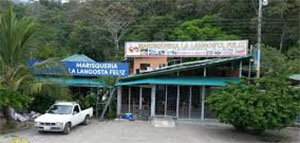 This month the ROMEOs traveled a little further than usual to a restaurant just above Matapalo, down the Costanera Sur (coastal highway south) not far from Dominical and about 30 km (18 miles) south of Quepos where we found La Langosta Feliz (The Happy Lobster). The restaurant is an unassuming place just off the Costanera; the look of it reminded me of what we called a "Lobstah Pool" where I grew up in northeast Massachusetts (ay-uh).
This month the ROMEOs traveled a little further than usual to a restaurant just above Matapalo, down the Costanera Sur (coastal highway south) not far from Dominical and about 30 km (18 miles) south of Quepos where we found La Langosta Feliz (The Happy Lobster). The restaurant is an unassuming place just off the Costanera; the look of it reminded me of what we called a "Lobstah Pool" where I grew up in northeast Massachusetts (ay-uh).
It's actually quite a sizable restaurant having two dining rooms that GG guesstimated could seat somewhere between 60 and a 100 diners (it was almost half filled for this off-season Saturday lunch). The decor is ELP (Early Lobster Pool) with stereotypical Tico wood furniture, plain tables and hard seats. The place doesn't have a pool where you select your own lobster but it does offer a wide variety of seafood. I presume the menu also offers other types of food but, having heard it's reputation, my eyes went right for the seafood. There is no view, like of the Pacific, but it is surrounded by a lot of local jungle greenery. Our group gave the La Langosta Feliz a composite score of 4.06 sloths out of 5 possible for ambiance.
GG and several others ordered a version of the several ceviche selections which included fish, shrimp, squid or mixed (my choice) for appetizers. A large banana split dish arrived (enough for a regular quick lunch by itself) with a very tasty combination of fresh minced seafood (except the shrimp were left whole) bathed in the typical lemon juice and cilantro mixture with just a tinge of something like Fresca in the mix - it was fresh and excellent.
For a main course GG ordered a fish fillet accompanied by three lobster tail halves (for those that may not know, lobster here is a rock lobster with a tail about 4" long). The dish was served with the Tico-typical small salad on the same plate as well as French fries. Everything was fresh and tasty and even the fries were better than average. By the comments going around the table I suspected the same was true for their food plates.
The dessert options were limited to three different types of toppings over cheesecake (GG took the caramel, breaking his low carb diet for the moment). The group gave a composite score of 4.36 for food quality. |
 |
|---|---|
| $$$.4 | |
Value Index=124 |
Jesús, our waiter, was kind and considerate and handled a party of eight quite well even if there were certain delays between courses (if I were Jesús I'd blame that on the kitchen). The group gave a composite score for service of 4.24, yielding an overall score for ambiance, food quality and service of 4.22.
For the ceviche, lobster/fish dish, cheesecake, one coke and a cup of coffee my bill came to 19,680 colones or just under $35, not at all too expensive for that amount of food, especially seafood. The composite score for cost came in at 3.40, yielding a Value Index of 4.22/3.40x100=124 and enrolling La Langosta Feliz in the top one third in value index of all the restaurants the ROMEOs have visited so far.
The ROMEO club can easily recommend La Langosta Feliz for an excellent meal at a reasonable cost, especially if you like seafood.
¡Solo Bueno!
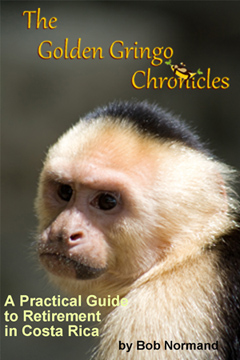 The story of the Golden Gringo Chronicles is also available as a hard copy novel of 192 pages available through Amazon and all major online retailers. ($9.95).
The story of the Golden Gringo Chronicles is also available as a hard copy novel of 192 pages available through Amazon and all major online retailers. ($9.95).
Amazon link: GGC, the Book. (Kindle Edition available)
Follow GG through the first six years of his odyssey in making the decision to retire in Costa Rica, overcoming the trials and tribulations of moving and obtaining residency there and the fun and experience of actually living in Ticoland.
Ride along with the Golden Gringo as he learns about the rich, varied culture of Costa Rica, the incredible bio diversity, the charming nature of the Costa Rican people and the ease with which a sometimes clueless ex-pat can assimilate into a small southwestern town on the Pacific coast.
Whether you are already a Costa Rican resident, someone contemplating a move here or just a traveler who enjoys different cultures, you will find the Golden Gringo Chronicles interesting, entertaining and informative about Costa Rica.
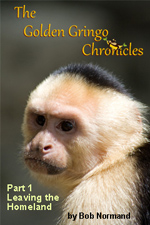 |
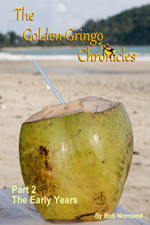 |
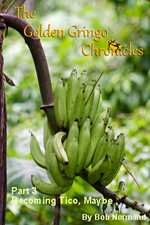 |
| Part 1 | Part 2 | Part 3 |
A narrative version of the Golden Gringo Chronicles is now also available as a trilogy of E-books in formats compatible with virtually all electronic platforms.
Part 1: (FREE!)
Leaving the Homeland
Click on Part Number above for E-book sample downloads or click the price above right for purchase. (The best price is on Part 1; it's FREE)
The Golden Gringo Chronicles is a free newsletter that is non-political, non-commercial and, hopefully, entertaining. By signing up you will receive an email each month around the first of the month giving you the links to the latest edition as well as to each individual feature and departmental section.
CLICK HERE TO SIGN-UP FOR THE
GOLDEN GRINGO CHRONICLES
or Email me at gg@goldengringo.com, and see our Website at: www.goldengringo.com

Bob Normand, Editor & The Golden Gringo
Pura Vida!
To Contact GGC World Headquarters (yuk, yuk) to make comments, suggest topics or criticize my bad jokes, just send an email to:
Be pithy but kind; I'm sensitive. (center)
Unsubscribe from Golden Gringo Chronicles